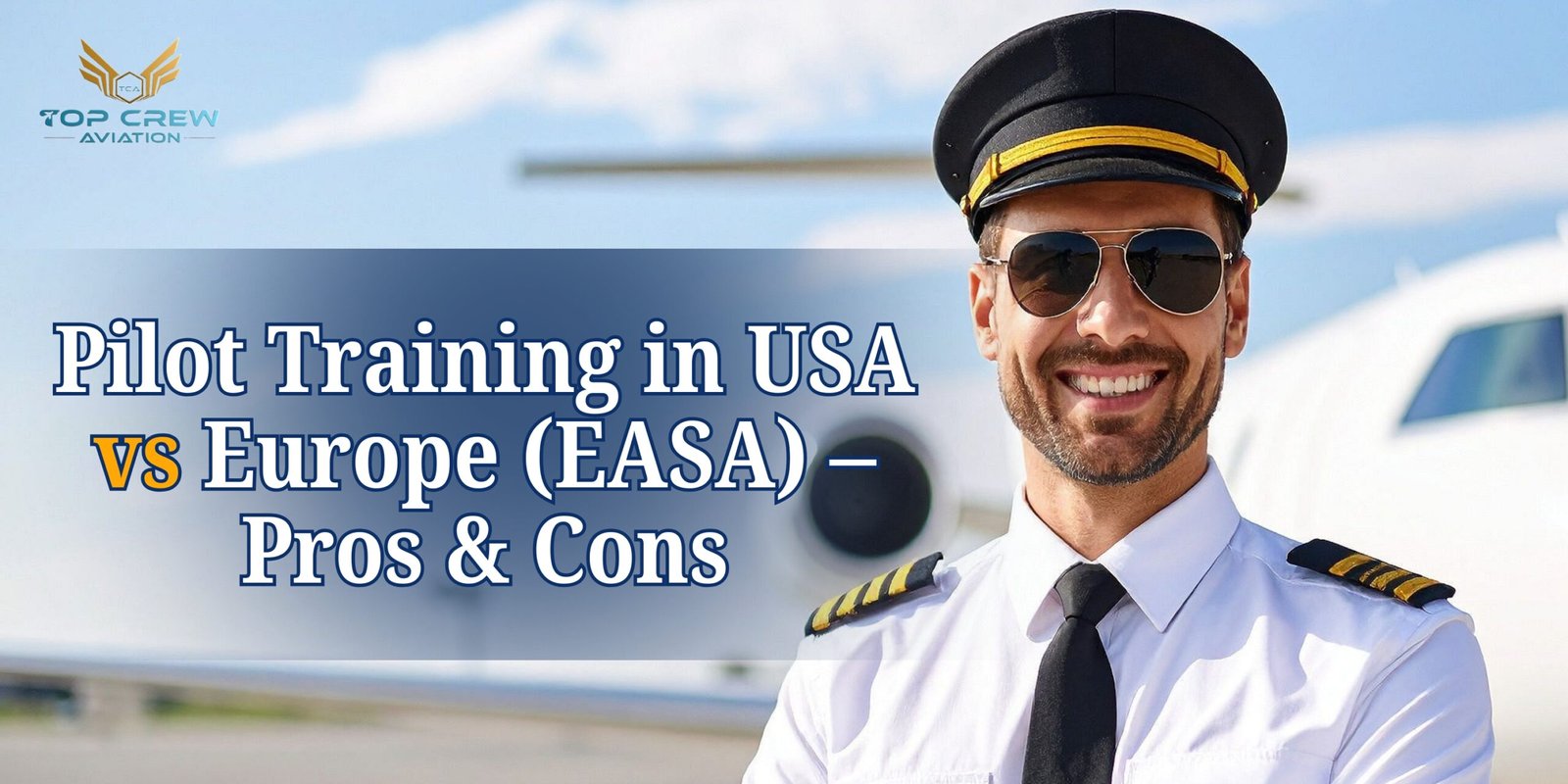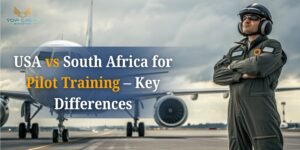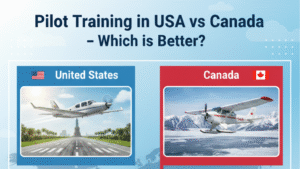Introduction
Choosing the right country for Pilot Training is one of the biggest decisions for any aspiring pilot. The USA and Europe (EASA system) are two of the most popular destinations for aviation students around the world. Both regions offer world-class training, but they follow different rules, costs, and licensing systems.
In this detailed blog, we will compare Pilot Training in USA vs Europe (EASA), understand the FAA vs EASA Pilot License difference, and analyze the pros and cons of each region to help you choose the best country for pilot training for Indian students and international aspirants.
USA vs Europe (EASA) Pilot Training Overview
The United States follows the FAA (Federal Aviation Administration) system, while Europe follows the EASA (European Union Aviation Safety Agency) system.
Both systems are globally recognized, but their training methods, costs, and conversion processes are quite different.
In the USA, the training environment is flexible and affordable, whereas EASA-based training in Europe is more structured and focused on airline-ready training programs.
Understanding FAA and EASA Pilot Training Systems
The FAA system (used in the USA) offers more flexibility. Students can progress at their own pace, log hours easily due to better weather, and gain more hands-on flying experience.
The EASA system (used across Europe) is more theoretical and classroom-oriented, emphasizing standardized learning and safety regulations.
| Comparison | FAA (USA) | EASA (Europe) |
| Authority | Federal Aviation Administration | European Union Aviation Safety Agency |
| Training Type | Modular (Flexible) | Integrated (Structured) |
| Focus | Practical flying hours | Theoretical and airline-ready skills |
| Weather Advantage | Excellent year-round | Seasonal (less flying in winters) |
This fundamental difference shapes how pilots are trained, licensed, and later employed.
Eligibility Criteria for Pilot Training in the USA and Europe
While both the USA and Europe have high standards, their eligibility criteria differ slightly:
In the USA (FAA)
- Minimum age: 17 years for Private Pilot License (PPL)
- Minimum education: 10+2 (Physics and Math required)
- Medical certificate from FAA-approved doctor
- Good English communication skills
In Europe (EASA)
- Minimum age: 18 years
- 10+2 with Physics and Mathematics
- Class 1 EASA medical certificate
- English proficiency test
Overall, eligibility requirements are quite similar, but EASA medical and theoretical exams are more stringent than FAA ones.
Flight Training Structure: Modular vs Integrated Programs
This is one of the biggest differences in Pilot Training in USA vs Europe.
FAA Modular Training (USA)
- Students can train step-by-step: PPL → CPL → IR → CFI
- Flexible schedule – great for students balancing studies or work
- Pay-as-you-go model makes it more affordable
- Students can build flying hours as instructors
EASA Integrated Training (Europe)
- A full-time, structured course (typically 18–24 months)
- Combines ground and flight training in one program
- Expensive but leads directly to an Airline Transport Pilot License (ATPL)
- Less flexibility but strong airline connections
So, if you prefer flexibility and lower costs, the USA is ideal. But if you want a direct airline pathway, the EASA system might suit you better.
Cost Comparison – USA vs Europe (EASA) Pilot Training
The cost of Pilot Training in USA and Europe varies greatly.
- USA (FAA): ₹45–55 lakh (USD 50,000–65,000)
- Europe (EASA): ₹75 lakh–₹1.2 crore (EUR 80,000–120,000)
The difference is because of:
- Higher aircraft rental and instructor costs in Europe
- Longer theoretical training duration
- Weather delays reducing flight time efficiency
If you’re an Indian student looking for value for money, the USA clearly offers more affordable and faster training options.
Training Duration and Flight Hours Difference
FAA Pilot Training in the USA typically takes 12–18 months, depending on weather and student pace.
EASA Pilot Training in Europe takes around 18–24 months, as it includes extensive theory and exams.
| Aspect | FAA (USA) | EASA (Europe) |
| Duration | 12–18 months | 18–24 months |
| Minimum Flying Hours | 250 | 200 |
| Theory Emphasis | Low | High |
| Flexibility | High | Low |
Because of the better flying weather in the USA, students can log more hours quickly — giving them a real flying advantage.
License Conversion: FAA to EASA and Vice Versa
Many students complete Pilot Training in the USA because it’s cheaper, and then convert their FAA license to EASA to work in Europe.
The FAA to EASA license conversion requires:
- Passing 13 EASA theory exams
- Additional flight training hours
- EASA medical certificate
- Skill test and English proficiency
Conversely, converting an EASA license to FAA is simpler — you mainly need an FAA check ride and documentation.
Hence, while FAA licenses are more flexible, EASA licenses are more region-specific.
Job Opportunities After Pilot Training in USA and Europe
After completing Pilot Training, job opportunities depend on where you train and get licensed.
In the USA
- Many FAA graduates work as flight instructors to build hours.
- Airlines like Delta, United, and American hire from FAA-approved schools.
- Easier to build flying hours quickly.
In Europe (EASA)
- Graduates are directly trained for Airline Transport Pilot License (ATPL) roles.
- Opportunities in airlines like Lufthansa, Ryanair, or EasyJet.
- However, competition is higher and hour-building is slower.
For Indian students, FAA training offers faster hour-building, while EASA offers better airline-readiness but at higher cost.
Weather and Flying Conditions – Which Is Better for Training?
Weather plays a huge role in Pilot Training.
The USA (especially states like Florida, Arizona, and California) enjoys clear skies most of the year, making flight scheduling easier.
Europe, on the other hand, has more cloudy, cold, and rainy months — often delaying flight lessons.
Better weather = more flight hours = faster training.
That’s why many Indian students prefer the USA for Pilot Training.
Quality of Flight Schools and Instructors
Both regions have excellent training schools, but the approach differs.
- FAA schools (e.g., ATP Flight School, Embry-Riddle, CAE Phoenix) focus on hands-on flying and personalized instruction.
- EASA schools (e.g., CAE Oxford, L3Harris, BAA Training) emphasize theory, discipline, and airline-level procedures.
If you want practical exposure and quicker licensing, USA schools are better.
If you prefer airline-style simulation and structured systems, Europe (EASA) wins.
Pros and Cons of Pilot Training in USA
Pros
- Lower training cost
- Faster license completion
- Better weather for flying
- Easier visa process for students
- Globally recognized FAA license
Cons
- License conversion required to work in Europe or Asia
- Limited airline pathway support compared to EASA
Pros and Cons of Pilot Training in Europe (EASA)
Pros
- Direct airline pathway with integrated ATPL
- Globally respected EASA license
- Strong safety and regulatory standards
- High-quality simulators and instructors
Cons
- Expensive training cost
- Unpredictable weather delays
- Limited flexibility in schedule
Conclusion – Which Is Better: USA or Europe (EASA)?
Both USA and Europe (EASA) have strong aviation training systems.
If you’re looking for affordable, fast, and flexible Pilot Training, the USA (FAA) system is ideal.
If you want structured, airline-ready training with global prestige, Europe (EASA) is a great option.
For Indian students, the USA often makes more sense due to cost, weather, and hour-building opportunities.
Ultimately, the best country for Pilot Training depends on your career goals — whether you dream of flying in America, Europe, or back home in India.
Final Thoughts
Choosing between Pilot Training in USA vs Europe isn’t just about money — it’s about where you want your aviation journey to take off.
Both paths can make you a world-class pilot; the difference lies in cost, training style, and your personal goals.



